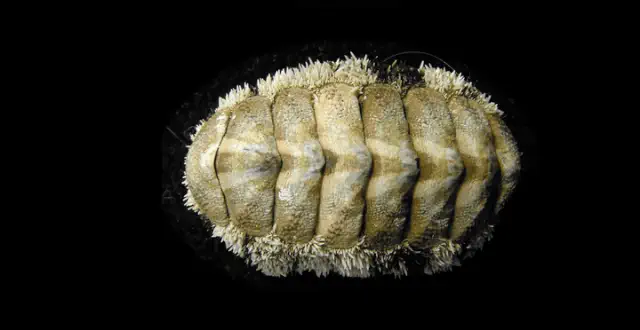This Marine Being Possesses a Body Covered in Eyes
View pictures in App save up to 80% data.
Chiton featuring thousands of 'eyes'. Image sourced from Science Magazine on Youtube.
Chitons possess distinctive 'eyes' that set them apart from all other organisms on the planet. These small lenses, known as ocelli, enable them to perceive light and shapes. Recent research has uncovered the evolutionary pathways that led to the development of these remarkable visual systems in various existing chiton species.
Chitons
View pictures in App save up to 80% data.
Acanthopleura granulata, commonly known as the West Indian fuzzy chiton, is a tropical species belonging to the chiton family. Image credit: PiterKrig via Depositphotos.
Chitons are marine mollusks That belong to the class Polyplacophora, which contains about 940 extant and 430 fossil species. Their aragonite shell plates allow them to flex and curl up into a ball for protection.
Chiton Habitat Chitons are marine mollusks that primarily inhabit rocky shorelines in intertidal zones. They are commonly found clinging to rocks and other hard surfaces, where they can withstand the harsh conditions of wave action and varying water levels. These creatures prefer areas with plenty of algae and other food sources, as they graze on these organisms using their specialized radula. Chitons are also capable of hiding in crevices and under boulders during low tide to protect themselves from predators and desiccation. Overall, their habitat is crucial for their survival, providing both nourishment and shelter.
View pictures in App save up to 80% data.
Acanthopleura haddoni is a tropical chiton species found in the Red Sea. This marine mollusk can often be seen clinging to rocks. Image sourced from depositphotos.
Chitons are typically seen clinging to rocks while feeding on algae, bryozoans, and diatoms. Nevertheless, certain species exhibit omnivorous or carnivorous feeding habits.
A Collection of Gazes
View pictures in App save up to 80% data.
Chiton. Photo courtesy of Deep Marine Scenes through Depositphotos.
A recent research study has shown that the ancestors of chitons developed eyes on four separate occasions, leading to the evolution of two unique types of eyes that are present in chitons today.
Aesthetic enthusiasts
View pictures in App save up to 80% data.
Acanthopleura haddoni is a tropical chiton species found in the Red Sea. This marine mollusk can often be seen clinging to rocks. Image sourced from depositphotos.
Their light-detecting components, known as aesthetes, are mixed with either larger ocular structures or smaller, more abundant eyespots that link to optic nerves through openings in the shell plates.
Shell Vision
View pictures in App save up to 80% data.
Image captured from “Marine life forms a multitude of eyes using its shell”, Source: “YouTube”, Uploaded by “Science Journal”
Chiton shell eyes are situated within their aragonite shells. Each of these 'eyes' comprises a lens, pigmented cells, and photoreceptor cells located beneath the lens. While the main role of these shell eyes is to sense light, researchers also think that ocelli may be capable of recognizing simple shapes.
Eye Markings
View pictures in App save up to 80% data.
Image captured from “Marine life forms a multitude of eyes using its shell”, Source: “YouTube”, Uploaded by “Science Journal”
View pictures in App save up to 80% data.
“Marine organism creates a thousand eyes from its shell”, Source: “YouTube”, Uploaded by: “Science Magazine”
Chitons featuring eyespots typically possess numerous slits across their shell segments. Like shell eyes, these eye spots are composed of a lens, a layer of pigmented cells that minimize light scattering, and photoreceptor cells located beneath the lens. Their primary role is to sense light.
The Evolutionary Theory
View pictures in App save up to 80% data.
Image captured from “Marine life forms a multitude of eyes using its shell”, Source: “YouTube”, Uploaded by “Science Journal”
Evolution describes how organisms developed from earlier life forms during the earth’s history. Charles Darwin introduced the concept of evolution.
The evolution of chitons, a class of marine mollusks known as Polyplacophora, is a fascinating subject that showcases the adaptability and resilience of these creatures over millions of years. Chitons are characterized by their distinctive eight overlapping shell plates, which provide protection and flexibility. Fossil evidence suggests that chitons have existed for at least 500 million years, dating back to the Cambrian period. Their evolutionary history reflects significant changes in marine environments, with chitons adapting to various habitats ranging from rocky shorelines to deep-sea ecosystems. Throughout their evolution, chitons have developed specialized feeding mechanisms, such as their radula, which allows them to scrape algae and other organic material from surfaces. Their ability to cling tightly to rocks using their muscular foot has also contributed to their survival in turbulent coastal waters. As researchers continue to study the genetic and morphological diversity of chitons, they gain insights into how these creatures have evolved in response to environmental changes and ecological pressures. Understanding chitons not only sheds light on their evolutionary journey but also provides valuable information about marine biodiversity and the health of ocean ecosystems.
View pictures in App save up to 80% data.
Acanthopleura haddoni is a tropical chiton species found in the Red Sea. This marine mollusk can often be seen clinging to rocks. Image sourced from depositphotos.
Researchers suggest that throughout their evolutionary history, chitons have developed four distinct types of visual systems, with two still in use today. Chiton species featuring fewer slits have adapted larger and more intricate shell eyes, whereas those possessing a greater number of slits have evolved numerous but simpler eyespots on their shells.
Chiton Varieties
Approximately 940 species of chitons, commonly referred to as polyplacophorans, exist. These marine mollusks are distinguished by their eight-part shells and inhabit a wide range of marine habitats across the globe.
Chitons primarily feed on algae, particularly those found on rocky surfaces. They use their rasping tongues, known as radulas, to scrape off the algae and other organic material from rocks and substrates in their marine environments. Some species may also consume small invertebrates or detritus.
View pictures in App save up to 80% data.
Acanthopleura haddoni is a tropical chiton species found in the Red Sea. This marine mollusk can often be seen clinging to rocks. Image sourced from depositphotos.
Chitons are herbivorous creatures that utilize their unique radula, a tongue-like structure adorned with numerous tiny, tough teeth, to scrape algae and various organic materials from rocky surfaces. While their main diet revolves around algae, they also feed on small invertebrates and detritus, helping to maintain the cleanliness of the marine ecosystem.
Yes, chitons play a significant role in their ecosystems. As herbivores, they graze on algae and other plant materials on rocky surfaces, helping to control algal growth and maintain the balance of the ecosystem. Their feeding habits can prevent overgrowth of algae, which can otherwise suffocate other marine organisms. Additionally, chitons serve as a food source for various predators, contributing to the food web. Their presence can indicate the health of their marine environment, making them important indicators of ecosystem health.
View pictures in App save up to 80% data.
Acanthopleura haddoni is a tropical chiton species found in the Red Sea. This marine mollusk can often be seen clinging to rocks. Image sourced from depositphotos.
Certainly! Chitons are vital for the health of their ecosystems. By feeding on algae, they help control its growth, preventing it from overwhelming coral reefs and other marine organisms. Their existence is essential for sustaining the delicate equilibrium of coastal marine habitats.
To observe chitons in their natural habitat, follow these steps: 1. **Research Locations**: Identify coastal areas where chitons are known to inhabit, such as rocky shorelines, tide pools, or intertidal zones. 2. **Timing**: Plan your visit during low tide, as this will expose more of the intertidal zone and increase your chances of spotting chitons. 3. **Equipment**: Bring along necessary equipment such as water shoes, a tide pool guidebook, and a camera for documentation. 4. **Look Closely**: Chitons often blend in with the rocks, so take your time to look closely at the surfaces of rocks and other substrates. They may be hiding under seaweed or in crevices. 5. **Observe Behavior**: Spend time quietly observing their behavior, as chitons can be shy. Look for movement or changes in their position. 6. **Respect the Environment**: Be mindful of the ecosystem. Avoid disturbing the rocks and surrounding marine life while observing chitons. 7. **Join a Guided Tour**: Consider joining a marine biology tour or a guided beach walk, where experts can provide insights and help you spot chitons more easily. By following these guidelines, you can enhance your chances of successfully observing chitons in their natural habitat.
View pictures in App save up to 80% data.
Acanthopleura haddoni is a tropical chiton species found in the Red Sea. This marine mollusk can often be seen clinging to rocks. Image sourced from depositphotos.
If you want to spot chitons, visit rocky coastlines when the tide is low. Search for them attached to rocks in tide pools or nestled beneath boulders. Approach with care and kindness—these ancient and hardy animals play an essential role in their ecosystems, and it’s important to keep their environments safe and undisturbed.
Summary
View pictures in App save up to 80% data.
Acanthopleura haddoni is a tropical chiton species found in the Red Sea. This marine mollusk can often be seen clinging to rocks. Image sourced from depositphotos.
This fascinating mollusk has evolved remarkable adaptations for safeguarding itself and perceiving its surroundings. Recent research offers insights into the evolutionary history of these captivating marine creatures.
Additional Updates on Animal News
View pictures in App save up to 80% data.
Acanthopleura haddoni is a tropical chiton species found in the Red Sea. This marine mollusk can often be seen clinging to rocks. Image sourced from depositphotos.
Latest posts by Cayla de Souza, M.Sc. Ocean Sciences & Marine Biology (see all)










